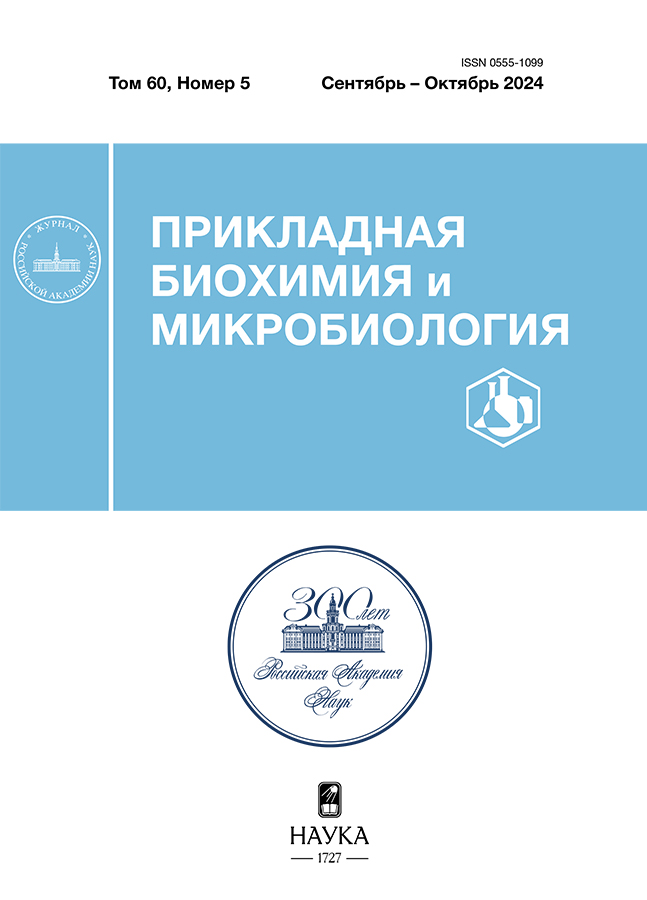Inducible whole-cell biosensor for detection of formate ions
- 作者: Cherenkova А.А.1,2, Yuzbashev Т.V.3, Melkina О.Е.1
-
隶属关系:
- National Research Center “Kurchatov Institute”
- Mendeleev University of Chemical Technology
- Rothamsted Research
- 期: 卷 60, 编号 5 (2024)
- 页面: 545-551
- 栏目: Articles
- URL: https://permmedjournal.ru/0555-1099/article/view/681862
- DOI: https://doi.org/10.31857/S0555109924050128
- EDN: https://elibrary.ru/QSTNOY
- ID: 681862
如何引用文章
详细
Ten strains of the yeast Yarrowia lipolytica were constructed, the genomes of which contain hrGFP gene under the regulation of the formate dehydrogenase promoters. The resulting strains can act as whole-cell biosensors for the detection of formate ions in various mediums. By visual assessment of biomass fluorescence, we selected the three most promising yeast strains. The main biosensor characteristics (threshold sensitivity, amplitude and response time) of the selected strains were measured. As a result, in terms of characteristics, the B26 strain was recognized as the most suitable for the detection of formate ions. A carbon source for the nutrient medium that does not reduce the activation of the biosensor was selected. Furthermore, we showed that unlike formate and formaldehyde, methanol practically does not induce the biosensor fluorescence response.
全文:
作者简介
А. Cherenkova
National Research Center “Kurchatov Institute”; Mendeleev University of Chemical Technology
Email: oligamelkina@gmail.com
Complex of NBICS Technologies
俄罗斯联邦, Moscow, 123098; Moscow, 125480Т. Yuzbashev
Rothamsted Research
Email: oligamelkina@gmail.com
Plant Sciences and the Bioeconomy
英国, West Common, Harpenden, AL5 2JQ, HertfordshireО. Melkina
National Research Center “Kurchatov Institute”
编辑信件的主要联系方式.
Email: oligamelkina@gmail.com
Complex of NBICS Technologies
俄罗斯联邦, Moscow, 123098参考
- Robles H. Encyclopedia of Toxicology. 2nd Ed. / Ed. P. Wexler: Elsevier, 2005. P. 378‒380.
- Cunha S., Rangaiah G.P., Hidajat K. Computer Aided Chemical Engineering. / Eds. A. Espuña, M. Graells, L. Puigjaner: Elsevier, 2017. V. 40. P. 1093‒1098.
- Larsson S., Palmqvist E., Hahn-Hägerdal B., Tengborg C., Stenberg K., Zacchi G., Nilvebrant N.O. // Enzyme Microb. Technol. 1999. V. 24. P. 151‒159.
- Zaldivar J., Martinez A., Ingram L.O. // Biotechnol. Bioeng.. 2000. V. 68. № 5. P. 524‒530.
- Кочетков А.В. // Строительные материалы. 2011. № 7. С. 44‒46.
- Triebig G., Schaller K.H. // Clin Chim Acta. 1980. V. 108. № 3. P. 355‒360.
- Ohmori S., Sumii I., Toyonaga Y., Nakata K., Kawase M. //J. Chromatogr. 1988. V. 426. № 1. P. 15‒24.
- Kim, J.K., Shiraishi T., Fukusaki E.I., Kobayashi A. // J. Chromatogr. A. 2003. V. 986. № 2. P. 313‒317.
- Abolin C., McRae J.D., Tozer T.N., Takki S. // Biochem. Med. 1980. V. 23. № 2. P. 209‒218.
- Campos A.F., Cassella R.J. // Food Chem. 2018. V. 269. P. 252‒257.
- Cheng Vollmer A., Van Dyk T.K. // Adv. Microb. Physiol. 2004. V. 49. P. 131‒174.
- Bazhenov S.V., Novoyatlova U.S., Scheglova E.S., Prazdnova E.V., Mazanko M.S., Kessenikh A.G. et al. // Biosens. Bioelectron. X. 2023. V. 13. https://doi.org/10.1016/j.biosx.2023.100323.
- Chistoserdova L., Laukel M., Portais J.C., Vorholt J.A., Lidstrom M.E. // J. Bacteriol. 2004. V. 186. № 1. P. 22‒28.
- Godfrey C., Coddington A., Greenwood C., Thomson A.J., Gadsby P.M. // Biochem. J. 1987. V. 243. № 1. P. 225‒233.
- Benoit S., Abaibou H., Mandrand-Berthelot M.A. // J. Bacteriol. 1998. V. 180. № 24. P. 6625‒6634.
- Sakai Y., Murdanoto A.P., Konishi T., Iwamatsu A., Kato N. // J. Bacteriol. 1997. V. 179. № 14. P. 4480‒4485.
- Патент ЕС. 1988. № 0299108A1.
- Overkamp K.M., Kötter P., van der Hoek R., Schoondermark-Stolk S., Luttik M.A., van Dijken J.P., Pronk J.T. // Yeast. 2002. V. 19. № 6. P. 509‒520.
- Kobayashi A., Taketa M., Sowa K., Kano K., Higuchi Y., Ogata H. // IUCrJ. 2023. V. 10. P. 544‒554.
- Патент Великобритания, Германия. 2022. № WO2022008929A1.
- Маниатис Т., Фрич Э., Сэмбрук Дж. Методы генетической инженерии. Молекулярное клонирование. Москва: Мир, 1984. 480 с.
- Yuzbashev T.V., Yuzbasheva E.Y., Melkina O.E., Patel D., Bubnov D., Dietz H., Ledesma-Amaro R. // Commun. Biol. 2023. V. 6. № 1. P. 858.
- Yurimoto H., Komeda T., Lim C.R., Nakagawa T., Kondo K., Kato N., Sakai Y. // Biochim. Biophys. Acta. 2000. V. 1493. P. 56–63.
- Hartner F.S., Glieder A. // Microb. Cell Fact. 2006. V. 5. P. 39.
- Chen N.H., Djoko K.Y., Veyrier F.J., McEwan A.G. // Front Microbiol. 2016. V. 7. P. 257.
- Liu A., Feng R., Liang B. // Enzyme Microb. Technol. 2016. V. 91. P. 59–65.
- Buttery J.E., Chamberlain B.R. // J. Anal. Toxicol. 1988. V. 12. № 5. P. 292–294.
- Ogata M., Iwamoto T. // Int. Arch. Occup. Environ. Health. 1990. V. 62. № 3. P. 227–232.
补充文件













